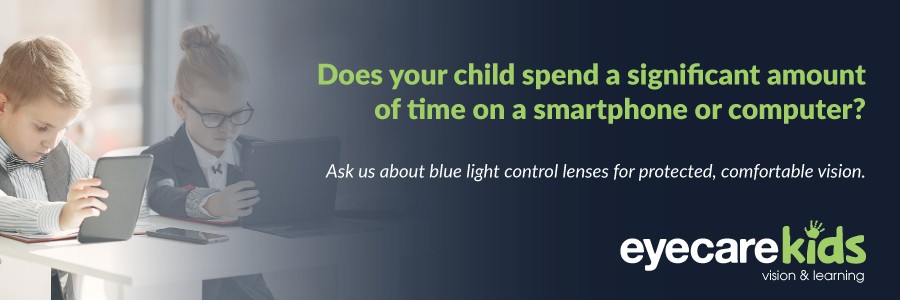Kids are now mostly studying from home and using technology for a good number of hours each day. After class, many would spend a few more hours staring at digital screens for leisure such as video gaming or watching movies.
What does increased screen time for kids mean for concerned parents and guardians?
1. Kids are using their near vision more than usual.
Our eyes are designed to look into the distance. When we do extended near work, this forces our ciliary body, or the eye muscle that allows humans to focus on near objects, to work overtime. As we concentrate on an object up close, that muscle contracts and remains contracted to maintain focus. Prolonged hours of near-work activity can cause eyestrain.

2. If your child does not have myopia (short-sightedness), there is a greater risk for them to develop it.
Myopia is on the rise, with a scientific projection that by the year 2050, half of the world’s population will become myopic.
The exact cause of myopia is unknown, but there is significant evidence that kids inherit myopia or, at least, the tendency to develop myopia. If one or both parents are short-sighted, there is an increased chance their children will be short-sighted.
While the tendency to develop myopia may be inherited, its actual development may be affected by how a child uses their eyes. Studies show that kids who spend considerable time reading, working at a computer, or doing other intense close visual work may be more likely to develop myopia.
3. They spend less time outdoors.
Naturally, if your child is spending more time indoors, this means their time spent outdoors is reduced. A lack of outdoor activity in kids is mainly the largest piece of evidence researchers are attributing to the cause of myopia’s rise. Read our related article here.
Other potential factors include increased time spent on digital devices and other near-work activities.
4. If your child is already short-sighted, there is a greater risk of their myopia progressing to moderate to high myopia.
More studies have shown that increased near work (reading, digital screens, etc.) may be a factor in the progression of myopia in children.
Preventing myopia progression is very important because of the serious eye conditions associated with high myopia such as glaucoma, macular degeneration, retinal detachment, and cataract.
5. Remember these two rules to help your child.
Totally eliminating screens isn’t practical, so what you can do is try to limit their screen time while encouraging frequent breaks. The 20-20-20 rule to prevent digital eye strain is good to remember: For every 20 minutes spent looking at a screen, your child should look at something 20 feet away for 20 seconds.
A recent new rule emerged to help with combat myopia and its progression: the 20-20-2 rule which states that “after 20 minutes of close work, children should gaze at objects in the distance for at least 20 seconds, and they should be outside intermittently for at least 2 hours per day.”
As for reading activities, you can help your child take breaks by inserting markers. When your child reaches a certain page, they need to stop reading for a while and look at an object far away.
6. A comprehensive eye test is now more important than ever.
Now that kids are using digital devices more than they used to, a professional assessment is necessary to check whether digital spectacles are needed to protect your child’s eyes from blue light emitted by digital screens. A comprehensive eye test can help determine whether your child’s eyes are working together as a team, not only checking for visual acuity.
If your child has myopia, it is important to discuss with your eyecare professional about the best treatment options for them to effectively control myopia progression before they become worse and lead to sight-threatening conditions. Kids optometrists such as Eyecare Kids offer the latest solutions for myopia treatment and management.

